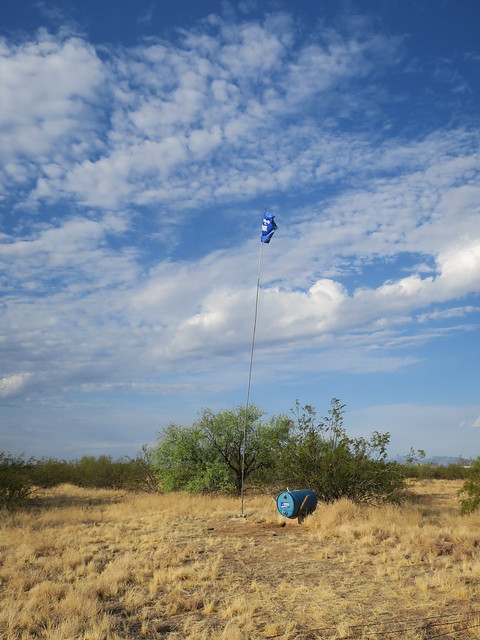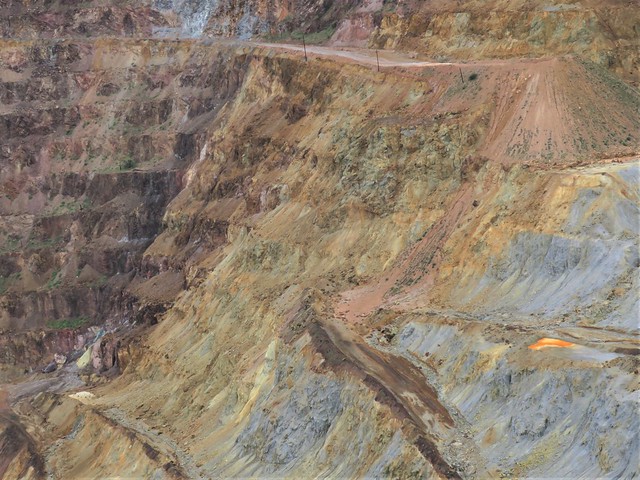 |
| Alvaro Enciso plants a Cross to honor a man who died seeking a decent life. Arizona. August 2019. |
On a Humane Borders water run, I learned about Alvaro Enciso, an artist who has made it a mission to recognize the humanity of individual women, men, and children who have died in the desert in an attempt to claim a decent life.
Mr. Enciso honors the dead with painted wood Crosses that he plants into the Arizona soil.
 |
| Alvaro Enciso plants a Cross to honor a man who died seeking a decent life. Arizona. August 2019. |
Each Cross has a round red disk.
 |
| Alvaro Enciso plants a Cross to honor a man who died seeking a decent life. Arizona. August 2019. |
The round red disk on a Cross represents a round red circle on the death map that Humane Borders maintains in partnership with the Pima County Medical Examiner's Office.
Each round red disk on the death map represents a woman, man, or child who died on their quest for a decent life. Each round red disk on the death map corresponds to a precise geographic point on the planet where the human remains of a dream were found.
 |
| Alvaro Enciso plants a Cross to honor a man who died seeking a decent life. Arizona. August 2019. |
There are so many collapsed dreams in the desert, individual collections of bone, sinew, skin, empty clothing, shoes, bags, papers. Maybe plastic baggies with garlic, dissolved in putrescence, to protect one from rattlesnake bites.
 |
| Garlic bulbs in a baggie, abandoned by a group of migrants, along with backpacks and other items, perhaps after pick-up by Border Patrol. Arizona. August 2019. |
Most Tuesdays, Mr. Enciso leads a one- or two-car pilgrimage into the Sonoran Desert or adjoining highlands. He has selected the women, men, or children whose deaths he will commemorate on a trip, and he brings the day's Crosses with him. Sometimes he knows a fallen person's name, gender, and age; sometimes not.
The color of the painted Crosses vary according to the tint of the paint that someone donated to him or that he picked up somewhere on sale.
Democracy Now recently devoted a show to Mr. Enciso's mission, and I'll direct you there so you can learn more about his work in his own words:
On the Cross pilgrimage I joined, there were small crews for ABC's Nightline and a freelance documentary company, and, I believe, a print journalist.
 |
| Alvaro Enciso plants a Cross to honor a man who died seeking a decent life. Arizona. August 2019. |
In all, there were at least 10 of us. Upon arrival near the first site, several of us carried something that was a part of the planting - a bucket, a shovel, quickset concrete. And the Cross. I carried the Cross, grateful to do so. It didn't weigh much, and it felt well-balanced. It rested lightly in the crook of my right arm. I occasionally smoothed the wood with my left hand.
We walked, and I held the Cross, and I thought about this man who had died, and when we arrived at the spot where his remains had been found, it was .... gosh, it was so pretty.
 |
| Alvaro Enciso plants a Cross to honor a man who died seeking a decent life. Arizona. August 2019. |
Which doesn't surprise me like it might have long ago. When I think of the Rwandan Genocide, and my friend who survived that cycle of human madness, a question invariably comes to me: "Did birds continue to sing in the forest canopy above the screams of slaughter below"?
Of course they did.
The desert enchants and kills indiscriminately, thus a place for a pretty walk on a pleasant day for one is a place of death from heat stroke or thirst for another.
After Mr. Enciso planted the Cross in that grassy meadow, we embarked on a rather wild ride in the Samaritans' two SUVs up into the highlands, very close to the border. Mr. Enciso sought the last living place of another man, for whom he had brought a Cross.
 |
| A man died in the saddle between those two peaks, in the search for a decent life. August 2019. |
But this was not the day it would happen. See that saddle between the two mountains? There's a wide valley between there and the rise where we parked. Volunteer Samaritans would come another day and hike to the man's death ground.
 |
| Samaritans left water for women, men, or children who might pass through. A man died in the saddle between those two peaks, in the search for a decent life. August 2019. |
The group left jugs of water in and under the shade of a tree, which looked across that valley. Maybe they will save a life. These jugs and barrels of water. They are an act of faith, or maybe more accurately, an act of hope in a lucky roll of metaphysical dice, that someone who needs water will see it and have still the strength to reach it.
Below is a slide show with more photos from this trip with Mr. Enciso, plus the accumulation of photos from the water runs to the Sonoran Desert via Humane Borders and Samaritans.


































